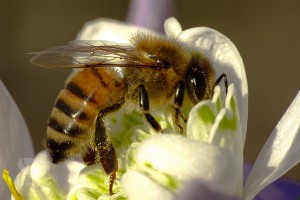Effect of chronic field-realistic exposure to the neonicotinoid, Imidacloprid, on honeybee colony health
A new study published by PLOS One shows that the neonicotinoid pesticide, imidacloprid, can have subtle negative effects on bee health. The study, conducted by Researchers from the University of Maryland and USDA-ARS conducted a three-year study to determine how imidacloprid levels within hives changed over time and how chronic low-level exposure to the neonicotinoid, imidacloprid effected honeybee colonies over time. Beehives in the field were fed bee food containing 5, 20, and 100 mg/kg of imidacloprid and then monitored for short term and long term colony performance. Samples were also taken from within the hive to test for pesticide residues. Researchers found that long-term colony survival rates decreased as the pesticide concentration increased and that colonies exposed to higher levels of pesticides had higher pesticide residues in their hives. Overall the study demonstrated that that while low level doses of imidacloprid were not likely to be the sole cause of bee declines, chronic, sub-lethal exposure to neonicotinoids at high field-realistic levels has negative impacts on hive health.



